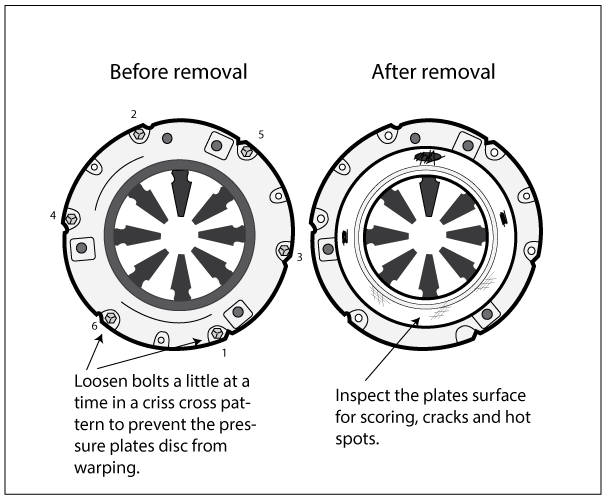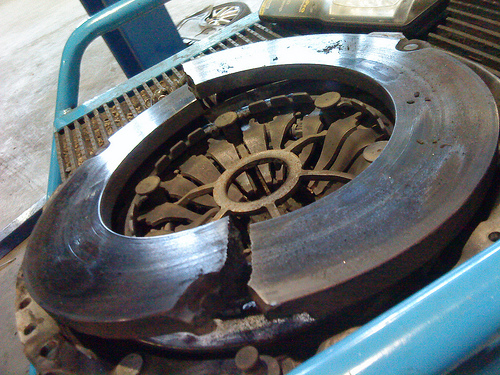
Clutch Fault is a faulty condition in which there is not enough friction in the clutch, so that engine speed rises without a corresponding increase in road speed.

There are four (4) main clutch faults, which are: Slip, Judder, Drag or spin, and Fierceness/Snatch
Slip – Symptoms;
When a gear ratio has been selected, the clutch pedal has been released and the accelerator pedal has been pushed down, and yet no power is transmitted to the driving wheels although the engine accelerates. This condition is indicated as slip. Also there may be smell of burning asbestos.
| Causes | Remedies |
| (a) Glazing of the surfaces, caused by oil or grease on the friction faces due to leakage from the engine crankcase or the gearbox or to excessive lubrication of the spigot shaft and its support bearing during assembly. (b) Clutch mechanism binding and incorrectly adjusted clutch pedal i.e. no free pedal movement or partial seizure of linkage or fouling of the pedal so as to prevent the full return of the linkage. (c) Worn-out driven-plate facings and defective pressure plate. |
Clean the components and renew the driven-plate. Check the linkage, rectify interference and adjust the linkage to provide correct clearance. Renew the driven-plate and pressure-plate assembly. |
Judder – Symptoms;
When the clutch is re-engaged by the gradual release of the clutch pedal but, instead of a smooth take-up, the combined engine-and-gearbox unit shudders and vibrates. This is known as judder, which is a severe low-frequency vibration, and normally occurs when the clutch is released and the vehicle is moved from stationary position.
| Causes | Remedies | |
| (a) Worn-out engine and gearbox rubber mountings. (b) Engine movement during the take-up of the drive, often caused due to body-to-engine tie-bar out of alignment. Inspect just the tie-bar. Wear in the drive line or suspension points can also cause this fault. |
Replace the mountings. Rectify the drive line or suspension points. |
|
| (c) The pressure-plate may be out of parallel with the flywheel face. (d) Distorted driven-plate or bent splined shaft causing uneven friction contact around the contact faces. (e) Misalignment of the engine to the gearbox, caused by incorrect assembly of the bell-housing to the engine. (/) Oil, grease, or other contamination causing uneven engagement. |
Reposition the pressure-plate, ensuring fitting of the location dowels and evenly tightening of the set-bolts. Check the alignment of the shaft and renew the driven plate. Check the bell-housing location dowels. Clean the flywheel and pressure-plate friction faces thoroughly and renew the driven-plate. |
Drag or Spin – Symptoms;
When it is difficult to engage a gear either when the vehicle is stationary or in motion, due to the driven-plate being dragged around even after the clutch pedal has acted to release it, then this condition occurs. In worst case, vehicle continues to move even when the pedal is fully depressed.
| Causes | Remedies |
| (a) Oil or grease on the driven-plate faces. (6) Misalignment between the engine and the splined clutch-shaft. (c) Insufficient clutch linkage movement preventing the release bearing from completely separating the driven-plate from the flywheel and pressure-plate faces. id) Damaged or distorted pressure plate or clutch cover. (e) Distorted driven-plate. (f) Driven-plate hub binding on the splined shaft. (g) Splined-spigot-shaft support bush or ball bearing binding. (h) Broken driven-plate or friction lining. (i) Dirt or foreign particles embedded in the driven plate faces. |
Clean the components, lubricate the splined shaft and spigot bearing, and renew the driven plate. Check the alignment of the engine-to-gearbox housing joint and realign. Adjust the linkage to provide correct free movement. Renew the pressure-plate and driven-plate. Renew the driven-plate, and the pressure-plate, if the release fingers or diaphragm spring appear to have been strained. Clean the driven-plate hub and splined shaft and lubricate with high-melting point grease. Check the bearing and either lubricate or renew it. Renew the driven plate. Renew the driven-plate. |
Fierceness/Snatch – Symptoms;
This condition exists when the clutch pedal is released instead of a gradual smooth take up of the drive, a snatch or jerky engagement of the engine with the transmission drive is experienced.
| Causes | Remedies | |
| (a) Oil or grease on the driven-plate faces causes uneven and irregular gripping of the driven-plate by the pressure-plate during engagement. | Clean all components, lubricate the splined shaft, and renew the drive-plate. | |
| (b) Clutch pedal linkage binding or contamination of fluid in the hydraulic operating system. (c) Worn-out driven-plate faces causing variation in friction grip during engagement. (cO Misalignment of the pressure-plate to the flywheel face. (e) Driven-plate damper springs loose or broken, causing ineffective cushioning action of the springs during clutch engagement. |
Check the cause of interference and rectify. Renew the driven-plate and if required also the pressure-plate. Check the pressure-plate location dowels and realign the pressure-plate to the flywheel and tighten the set-bolts evenly. Renew the driven plate. |
